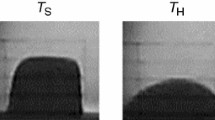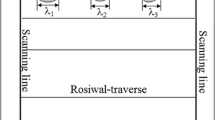Abstract
Casting powders are used in the continuous casting process of steels. These powders contain several oxides, fluoride compounds and carbonaceous materials. The decomposition kinetics of these carbonaceous materials regulates the melting rate of casting powders. In a previous work, a decomposition kinetics of two carbonaceous materials (coke and graphite) added to a casting powder was studied. Based on those data, in the present work, master decomposition curves (MDC) of these powders were constructed. For this, the values of both the activation energy (E) and the degree of decomposition (α), obtained in the thermogravimetric tests, were used for each heating rate (β). Then, the work of decomposition (θ D) was calculated and the MDC was obtained. From the MDC, it was possible to predict the time (t) needed to produce a given degree of decomposition (α) at different temperatures (T). Taking this into account, it was possible to validate the master decomposition curves through different thermal treatments, where the degree of decomposition was calculated by interpolating the MDCs. These values were compared with those determined experimentally by measuring the mass loss in each heat treatment. In all cases, the results showed a good correlation between the predicted and measured values. It is concluded that the use of the MDC represents a useful tool to evaluate and compare the behavior of carbonaceous materials added to casting powder.





Similar content being viewed by others
References
Mills KC, Fox AB, Li Z, Thackray RP. Performance and properties of mould fluxes. Ironmak Steelmak. 2005;32:26–34.
Branion RV. Mold fluxes for continuous casting. Iron Steelmak. 1986;13:41–50.
Brandaleze E, Di Gresia G, Santini L, Martín A, Benavidez E. Mould fluxes in the steel continuous casting process. In: Srinivasan M, editor. Science and technology of casting processes. Rijeka: InTech; 2012. p. 205–33.
Kawamoto M, Nakajima K, Kanazawa T, Nakai K. Design principles of mold powder for high speed continuous casting. ISIJ Int. 1994;34:593–8.
Brandaleze E, Santini L, Gorosurreta C, Benavidez E, Martin A. Influence of carbonaceous particles on the melting behaviour of mold fluxes at high temperature. Proceedings 16º steelmaking conference IAS. San Nicolás, Argentina 2007; pp. 363–71.
Wei E, Yang Y, Feng C, Sommerville ID, McLean A. Effect of carbon properties on melting behavior of mold fluxes for continuous casting of steels. J Iron Steel Res. 2006;13:22–6.
Benavidez E, Santini L, Brandaleze E. Decomposition kinetic of carbonaceous materials used in a mold flux design. J Therm Anal Calorim. 2011;103:485–93.
Park SJ, German RM. Master curves based on time integration of thermal work in particulate materials. Int J Mater Struct Integr. 2007;1:128–46.
Diantonio CB, Ewsuk KG, Bencoe D. Extension of master sintering curve theory to organic decomposition. J Am Ceram Soc. 2005;88:2722–8.
Su H, Johnson DL. Master sintering curve: a practical approach to sintering. J Am Ceram Soc. 1996;79:3211–7.
Ewsuk KG, Ellerby DT, DiAntonio CB. Analysis of nanocrystalline and microcrystalline ZnO sintering using master sintering curves. J Am Ceram Soc. 2006;89:2003–9.
Caruso R, Mamana N, Benavidez E. Densification kinetics of ZrO2-based ceramics using a master sintering curve. J Alloys Compd. 2010;495:570–3.
Bothara M, Atre SV, Park SJ, German RM, Sudarshan TS. Sintering behavior of nanocrystalline silicon carbide using a plasma pressure compaction system: master sintering curve analysis. Metall Mater Trans. 2010;41:3252–61.
Enneti RK, Bothara MB, Park SJ, Atre SV. Development of master sintering curve for field-assisted sintering of HfB2-20SiC. Ceram Int. 2012;38:4369–72.
Atre SV, Enneti RK, Park SJ, German RM. Master decomposition curve analysis of ethylene vinyl acetate pyrolisis: influence of metal powders. Powder Metall. 2008;51:368–75.
Aggarwal G, Park SJ, Smid I, German RM. Master decomposition curve for binders used in powder injection molding. Metall Mater Trans A. 2007;38:606–14.
Enneti RK, Shivashankar TS, Park SJ, German RM, Atre SV. Master debinding curves for solvent extraction of binders in powder injection molding. Powder Technol. 2012;228:14–7.
Chrissafis K. Kinetics of thermal degradation of polymers. J Therm Anal Calorim. 2009;95:273–83.
Sánchez-Jiménez PE, Criado JM, Pérez-Maqueda LA. Kissinger kinetic analysis of data obtained under different heating schedules. J Therm Anal Calorim. 2008;94:427–32.
Mianowski A, Bigda R, Zymla V. Study on kinetics of combustion of brick-shaped carbonaceous materials. J Therm Anal Calorim. 2006;84:563–74.
Li L, Tan Z-C, Meng S-H, Wang S-D, Wu D-Y. Kinetic study of the accelerating effect of coal-burning additives on the combustion of graphite. J Therm Anal Calorim. 2000;62:681–5.
Badenhorst H, Rand B, Focke WW. Modelling of natural graphite oxidation using thermal analysis techniques. J Therm Anal Calorim. 2010;99:211–28.
Badenhorst H, Focke WW. Geometric effects control isothermal oxidation of graphite flakes. J Therm Anal Calorim. 2012;108:1141–50.
Acknowledgements
The authors wish to thank Universidad Tecnológica Nacional (Argentina) for the financial support of this work.
Author information
Authors and Affiliations
Corresponding author
Rights and permissions
About this article
Cite this article
Benavidez, E., Santini, L., Martín, A. et al. Master decomposition curve of carbonaceous materials used in casting powders. J Therm Anal Calorim 133, 695–701 (2018). https://doi.org/10.1007/s10973-017-6892-1
Received:
Accepted:
Published:
Issue Date:
DOI: https://doi.org/10.1007/s10973-017-6892-1




